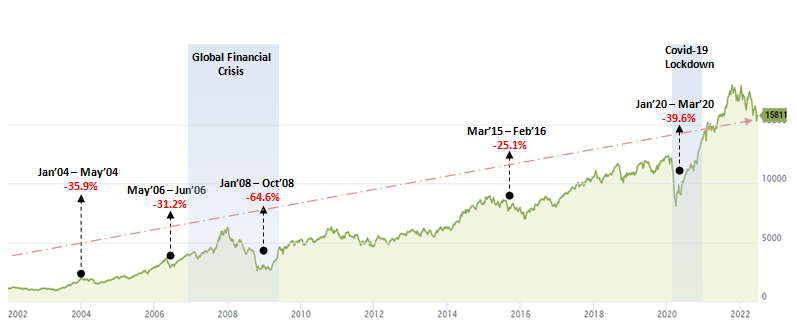- General
If there’s anything two years of the pandemic have shown us, it’s that downturns- both in life and the economy- can come out of nowhere. So what sets a great investor apart? As much as we’d like to believe that the best investors always take profitable calls, never panic at the sight of their portfolio, and can see a crash coming from a mile away, Warren Buffett proves that the exact opposite is true with his quote: ‘The stock market is designed to transfer money from the active to the patient.’ So while agility can mean the start of a good portfolio, it is only endurance and discipline that set the good apart from the great.
There’s one big difference between the greatest athlete and the best investor. Usain Bolt can’t get his coach to run a race for him. That’s a privilege exclusive to us regular folks. As investors, sometimes the best thing to do is simply trust the process as well as the experts. Tuneout the voice of the crowd by staying away from wild speculation on the news and online. If you have a long-term investment strategy and the measured advice of a financial expert, you'll be far less likely to follow a panicking herd over a cliff. You don’t have to take every call or run every mile. Your greatest contribution in the long run (pun intended) can sometimes just be making sure the race is completed, and not pulling up the finish line from 400m to a 100. This is beginning to sound a lot more like a sports metaphor than an investment newsletter, so we’ll stop right here.
The past couple of quarters have been quite volatile. The surging inflation coupled with monetary tightening, depreciating currencies, impact of protracted Ukraine- Russia conflict on commodity prices globally and supply chain issues have sent Indian stocks spiraling down from all-time highs. Its been a roller-coaster ride and markets have been volatile after Nifty peaking at 18,604 in October 2021. If you think of it, there are only handful of markets which have stayed resilient like India, China, USA, Mexico. While in the short term China is regaining, the good part is that India has been favoured by global investors vs China in the last 12 months. Proof of the pudding is also that the Indian currency is better placed relative to its peers.
The average length of a bear market is 289 days, or about 9.6 months. That's significantly shorter than the average length of a bull market, which is 991 days or 2.7 years. Every 3.6 years: That's the long-term average frequency between bear markets.
It is usually believed when any index or stock is 20% or more down from its all-time highs, it is in a bear market. Here is a glimpse of 5 bear phases that set Indian market down in the past 20 years. With every bear phase comes a bull phase. One of the biggest bull markets witnessed in India had two bear phases 2004 and 2006. So, healthy corrections are a part of the cycle even in bull markets. In every bear market, the seeds of a bull run are sown.

While the last one year may not have been the best demonstration of these figures, what goes down does come back up. Even serious investors can lock in their losses by exiting a crashing market rather than buying their way through a bear market, only to reap the rewards for years to come. The bottom line and the finish line certainly have a lot in common, and we couldn’t be happier to be on your team, even during these uncertain times. We here at Ace Lansdowne, while envisaging long term and superior returns, wisely select our portfolio that largely emphasizes on Qualitative Growth and Sustainability and avoid following the herd mentality.
We hope that when the noise around the market becomes too overwhelming, this newsletter reminds you of the motto of champions: ‘On your mark, Get set, Stay.’